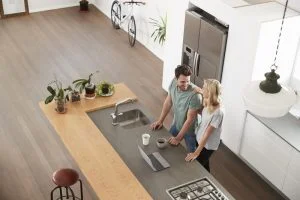
Home Flooring Replacement: 4 Important Considerations
If you’re part of the 66.1 percent of the American population the U.S. Census Bureau identifies as homeowners, you may be considering some upgrades in the coming year, including replacing your worn-out flooring. Striking Remodels by Bell is not in the flooring business, but as we offer kitchen remodeling and bathroom remodeling services, we wanted to share some important tips with you, should you be considering replacing your flooring during a bathroom or kitchen remodel. The process begins with budgeting and choosing your new flooring, but the process doesn’t end after you’ve called a contractor. Continue to read on for important considerations that include everything from discarding old materials to potential safety hazards if you do decide to tackle the project yourself.
Flooring Types and Home Value
Metropolitan Research Center Director, Arthur Nelson, tells The Atlantic that, in spite of the housing slump, Americans remain as eager as ever to sell their homes. Whether your prospective sale is sparked by Baby Boomer downgrading, Gen X upgrading, or a job-related move, tread lightly. Flooring considerations should be determined by the potential impact on a home’s value, a concept best tackled by a real estate agent. In general, high-quality wood trumps all other materials, with an estimated 6 percent increase when hardwood replaces carpet, according to MSN Real Estate. Materials such as bamboo also prove worthy of investment, and at the moment, maybe easier on your budget.
Child and Senior Friendly Floor Considerations
The ages of your family members could ultimately determine the type of flooring most appropriate for your home. While young adults happily adapt to nearly any type of flooring material, children and seniors may require safer alternatives. The grip remains essential for preventing tumbles; according to the National Floor Safety Institute, half of all accidental deaths that take place in the home result from falls. The NSFI suggests using non-slip flooring in homes with youth and elderly residents.
Flooring Removal and Associated Debris
So you’ve decided that new flooring is in the best interest of your home’s design, comfort and monetary value. Next, determine how much trouble you’re willing to go through to achieve this all-important end. Floor removal causes quite the mess and you’ll be responsible for keeping your property presentable throughout the ordeal. You may require an extra vessel for flooring debris, a provision that Next Day Dumpsters in Baltimore highlights as particularly important in neighborhoods with finicky homeowners associations. Be sure to check local regulations regarding extra dumpster placement, as many neighborhood bureaucracies heavily restrict when and where such facilities can be placed.
Volatile Organic Compounds and Floor Safety
Safety concerns should remain front and center as you replace your worn-out flooring. Volatile organic compounds, or VOCs, can prove especially problematic, as excessive contact could cause allergic reactions, asthma attacks, and a wide array of other negative health effects. Found in everything from interior plastics to (you guessed it!) hardwood floors, VOCs are particularly potent in new materials. The San Francisco Chronicle points to refinishing as a prime cause of high VOC levels, with these compounds lingering in hardwood floors for months, or in extreme cases, years. It’s impossible to completely avoid VOCs in homes with hardwood floors, but you can hasten their removal by opening windows to maximize ventilation. In homes with limited ventilation opportunities, air purifiers provide viable alternatives.
